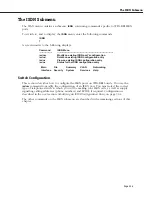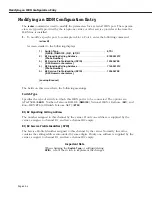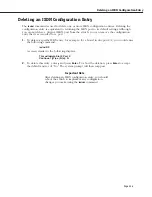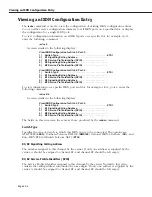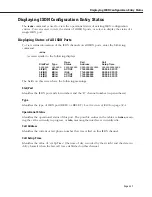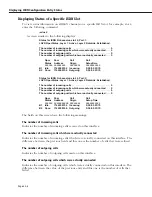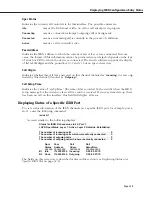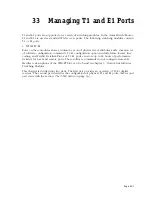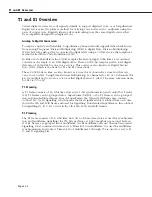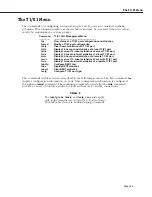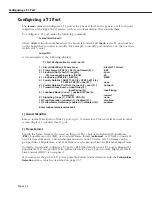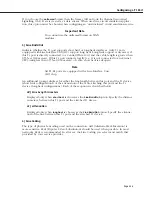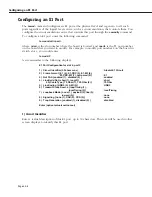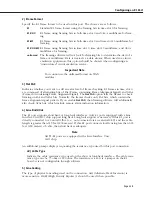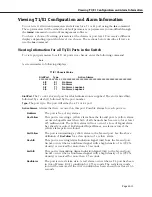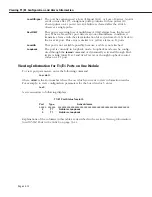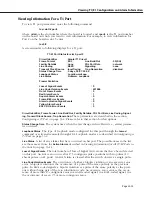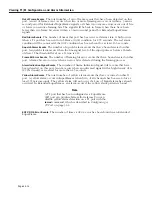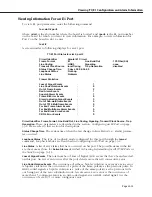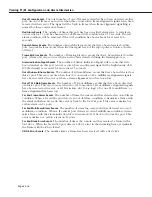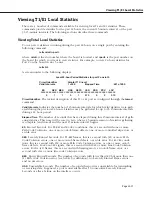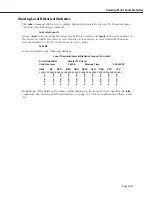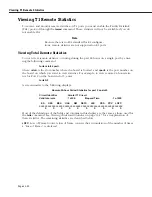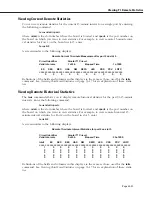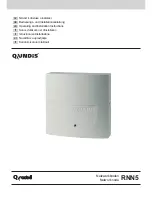
Configuring a T1 Port
Page 33-7
8) Loopback Mode
The loopback configuration for this port. Loopback configurations describe the relation
between the device attached to a
T1
port and the framing functionality within the
T1
port.
Framing functionality assembles
T1
frames into SuperFrames and Extended SuperFrames,
depending on how the port is configured. Possible values are as follows:
none
The port is not in a loopback state. This is the typical live network state for a
T1
port.
payload
The received signal at this
T1
port is looped out of the port after passing
through the port’s framing functionality. This state should only be used for
debugging purposes.
line
The received signal at this
T1
port does not go through the port’s framing func-
tionality, and is looped straight back out the port. This state should only be
used for debugging purposes.
inward
The transmitted signal from the
inward
side of this port is looped back inter-
nally. The signal passes through the
T1
framing functionality before looping
back. This state should only be used for debugging purposes.
9) Signaling
The type of signaling used on this port. Only the
none
and
CAS
(Channel Associated Signal-
ling) options are applicable to a circuit emulation service port. The
CCS
(Common Signal
Channeling) option is used with external
ISDN
Primary Rate ports. If you select the
CAS
option, then you are enabling robbed-bit signalling.
Robbed-bit signalling can be used with SuperFrames or Extended SuperFrames. In each
SuperFrame, the 6th and 12th frame may contain “robbed bit” (A, B) signalling, which means
the least significant bit is robbed from each time slot in the 6th and 12th frame and used for
signalling. In Extended SuperFrames, this robbed-bit signalling (A, B, C, D) occurs in the 6th,
12th, 18th, and 24th frames.
10) Trap Generation
Enables all of the
SNMP
-based traps related to T1 and E1 ports.
11) Yellow Alarm Detection
Specify the yellow alarm detection state for this port. A T1 port configured as SuperFrame
(SF) can produce false yellow alarms if a Layer 2 protocol like High-Level Data Link Control
(HDLC) is being used. Therefore, you can disable yellow alarm detection with this option. (A
T1 port set to Extended SuperFrame (ESF) will not produce false yellow alarms.)
Содержание Omni Switch/Router
Страница 1: ...Part No 060166 10 Rev C March 2005 Omni Switch Router User Manual Release 4 5 www alcatel com ...
Страница 4: ...page iv ...
Страница 110: ...WAN Modules Page 3 40 ...
Страница 156: ...UI Table Filtering Using Search and Filter Commands Page 4 46 ...
Страница 164: ...Using ZMODEM Page 5 8 ...
Страница 186: ...Displaying and Setting the Swap State Page 6 22 ...
Страница 202: ...Creating a New File System Page 7 16 ...
Страница 270: ...Displaying Secure Access Entries in the MPM Log Page 10 14 ...
Страница 430: ...OmniChannel Page 15 16 ...
Страница 496: ...Configuring Source Route to Transparent Bridging Page 17 48 ...
Страница 542: ...Dissimilar LAN Switching Capabilities Page 18 46 ...
Страница 646: ...Application Example DHCP Policies Page 20 30 ...
Страница 660: ...GMAP Page 21 14 ...
Страница 710: ...Viewing the Virtual Interface of Multicast VLANs Page 23 16 ...
Страница 722: ...Application Example 5 Page 24 12 ...
Страница 788: ...Viewing UDP Relay Statistics Page 26 24 ...
Страница 872: ...The WAN Port Software Menu Page 28 46 ...
Страница 960: ...Deleting a PPP Entity Page 30 22 ...
Страница 978: ...Displaying Link Status Page 31 18 ...
Страница 988: ...Displaying ISDN Configuration Entry Status Page 32 10 ...
Страница 1024: ...Backup Services Commands Page 34 14 ...
Страница 1062: ...Diagnostic Test Cable Schematics Page 36 24 ...
Страница 1072: ...Configuring a Switch with an MPX Page A 10 ...
Страница 1086: ...Page B 14 ...
Страница 1100: ...Page I 14 Index ...

